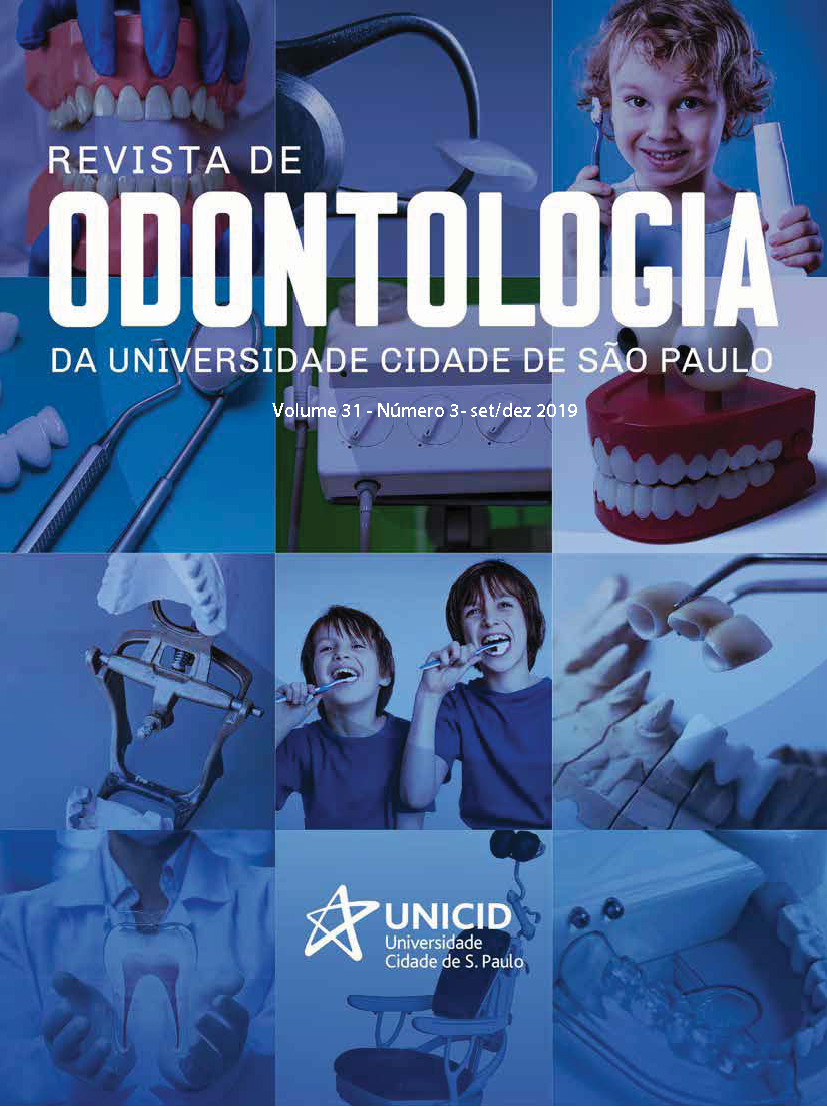Barra transpalatina, características e aplicações clínicas: revisão de literatura
DOI:
https://doi.org/10.26843/ro_unicidv3132019p48-60Palavras-chave:
Ortodontia, Má OclusãoResumo
O estudo apresentado tem por objetivo discorrer sobre a utilização da barra transpalatina na prática clínica e ortodôntica. A ativação da barra gera uma série de forças clinicamente úteis para mover os molares superiores. Este dispositivo de fácil confecção apresenta importantes funções tais como: auxiliar na ancoragem, expansão e contração dos arcos, correção das rotações de molares, controle do torque e inclinações de molares, controle da extrusão de molares, correção da mordida cruzada unilateral e auxiliar no movimento de distalização dos molares no arco superior. O conhecimento das possibilidades de emprego da barra transpalatina constitui um importante recurso auxiliar na terapia ortodôntica.Downloads
Referências
Ramos AL, Sakima MT, Pinto AS, Martins LP, Raveli DB. Barra palatina. Rev Dent Press Ortodon Ortop Facial 2000;5(1):75-100. 2. Harold JN. Classification of malocclusion. The Angle Orthodontist:. 1942;12(1):39-46. 3. Rebellato J. Actualidades em ortodontia: Premier; 1997. 4. Mcnamara JR JA, Brudon WL. Orthodontic and orthopedic treatment in the mixed dentition. Ann Arbor: Needham Press; 1993. 5. Dahlquist A, Gebauer U, Ingervall B. The effect of a transpalatal arch for correction of first molar rotation. Eur J Orthod. 1996;18(3):257-67. 6. Reynolds JM, Arai HY. Welcome to the world of orthodontics: Zulauf Associates; 1973. 7. Burstone CJ, Manhartsberger C. Precision lingual arches: passive applications. J Clin Orthod. 1988;22(7):444-51. 8. Graber TM, Vanarsdall RL. Orthodontics: current principles and techniques. St. Louis Mosby. 9. Barbosa JA. Entrevista R Clin Ortodon Dental Press. 2003;2(3):5-11. 10. Barbosa JA, Arsati Y, Tavano O, Miyamura ZY, Steca Barbosa C. Controle vertical do processo dentoaveolar com o uso da barra transpalatina: vertical control of the dento alveolar process. RGO. 2003;51(4):276-8. 11. Burstone CJ. The mechanics of the segmented arch techniques. Angle Orthod. 1966;36(2):99-120. 12. Roth RH. Mecánica de tratamiento para el aparato de alambre recto. In: Grabger, TMS, B. F., editor. Ortodoncia: principios generales y técnicas. Buenos Aires: Panamericana; 1988. p. 763-825. 13. Kupietzky A, Tal E. The transpalatal arch: an alternative to the Nance appliance for space maintenance. Pediatr Dent. 2007;29(3):235-8. 14. Kanashiro LK, Fantini SM. Barra transpalatina no tratamento ortodôntico: parte I. Ortodontia. 2002;35(2):161-70. 15. Marchi LC, Aidar LAA, Cappellette Júnior M, Guilherme A, Abrahão M. Considerações sobre a mecânica de Cetlin: relato de caso. Rev Clín Ortod Dent Press. 2003;2(1):37-44. 16. Ricketts RM. Occlusion: the medium of dentistry. J Prosthet Dent. 1969;21(1):39-60. 17. Lemons FF, Holmes CW. The problem of the rotated maxillary first permanent molar. Am J Orthod. 1961;47:246- 72. 18. McNamara JR JA, Brudon WL. Orthodontic and orthopedic treatment in the mixed dentition. Ann Arbor: Needham Press; 1994. 19. Andrews LF. The six keys to normal occlusion. Am J Orthod. 1972;62(3):296-309. 20. Cetlin NM, Hoeve, AT. Nonextraction treatment. J Clin Orthod. 1983;17(6):396-413. 21. Lazzara DJ. Lingual force on the Goshgarian palatal bar. Chicago: Faculty of the Graduate School of Loyola University of Chicago; 1976. 22. Weisenberg M. The influence of the Goshgarian palatal bar on the anteriorposterior positioning of the tongue. Chicago: Faculty of the Graduate School of Loyola University of Chicago; 1976. 23. McNamara JR JA, Brudon WL. Orthodontic and orthopedic treatment in the mixed dentition. Ann Arbor: Needham Press; 1994. 24. Ramos AL. A barra palatina e as geometrias das ativações. São Paulo: Santos; 2003. 25. Kucher G, Weiland FJ. Goal-oriented positioning of upper second molars using the palatal intrusion technique. Am J Orthod Dentofacial Orthop. 1996;110(5):466-8. 26. Ingervall B, Gollner P, Gebauer U, Frohlich K. A clinical investigation of the correction of unilateral first molar crossbite with a transpalatal arch. Am J Orthod Dentofacial Orthop. 1995;107(4):418- 25. 27. Melsen B, Bonetti G, Giunta, D. Statically determinate transpalatal arches. J Clin Orthod. 1994;28(10):602-6. 28. Corbett MC. Molar rotation and beyond. J Clin Orthod. 1996;30(5):272-5. 29. Ten, HA. Palatal bar and lip bumper in nonextraction treatment. J Clin Orthod. 1985;19(4):272-91. 30. Almeida MR, Almeida RR, Pedrin RRA. A utilizaçäo da barra transpalatina modificada na correçäo da mordida cruzada unilateral de molares. J Bras Ortodon Ortop Facial. 2001;6(36):510-24. 31. Natalizio P. Nota clínica: I? uso della barra transpalatina nel trattamento ortodontico. Arch Stomatol Napoli. 1985;23(3): 275-82. 32. Buranello FS, Cambaúva RDP, Nery CG. Barra transpalatina modificada. Rev Clín Ortodon Dental Press. 2011;10:333-40.

